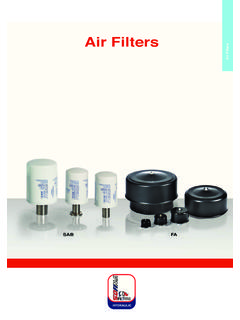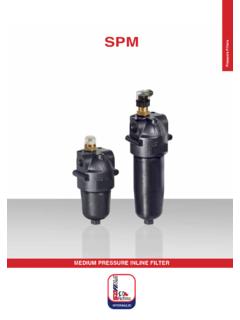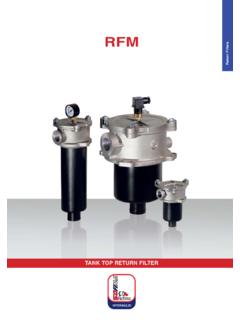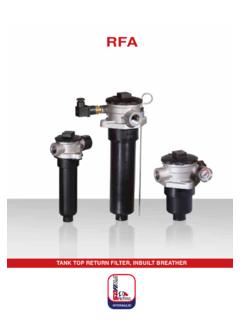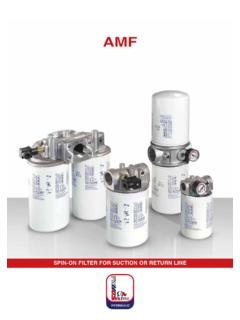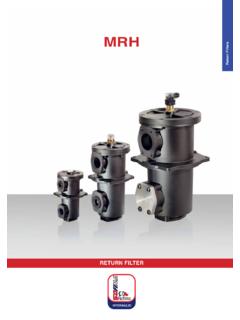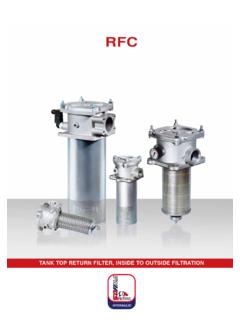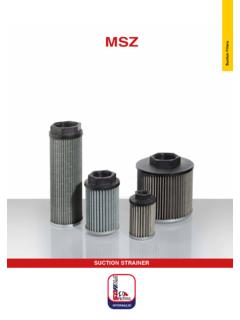Transcription of CONTAMINATION CONTROL IN HyDRAULIC …
1 CONTAMINATION CONTROL in the HyDRAULIC system is a very wide and complex matter; the following is just a short Customer Service is at your disposal for any further function of the fluid in the HyDRAULIC systems is transmitting forces and view of a reliable and efficient operation of the system, it is very important to select the fluid considering the requirements of the system and the specific working conditions (working pressure, environment temperature, location of the system, etc.).Depending on the required features (viscosity, lubricant capacity, anti-wear protection, density, resistance to ageing and to thermal variances, materials compatibility, etc.), the proper oil can be selected among a number of mineral oils (the most popular), synthetic fluids, water based fluids, environmental friendly fluids, the HyDRAULIC fluids are classified according to international CONTAMINATION is recognized as the main reason for malfunction, failures and early decay in HyDRAULIC systems; it is impossible to eliminate completely it, but it can be well kept under CONTROL with proper devices (filters).
2 No matter which fluid is used, it must be kept at the CONTAMINATION level required by the most sensitive component used on the THE CONTAMINATION IS MEASUREDThe CONTAMINATION level is measured by counting the number of particles of a certain dimension per unit of volume of the fluid; this number is then classified in CONTAMINATION Classes, according to international is made with Automatic Particle Counters that can make the analysis on line (through sampling connectors put on the system for this purpose) or from sampling calculations and sampling of the fluid must be done according to the specific ISO norms, to attest their most popular standard for CONTAMINATION Classes in the HyDRAULIC systems is ISO 4406:1999.
3 The standard NAS 1638 (under revision) is also quite CLASSES ACCORDING TO ISO 4406:1999 The CONTAMINATION Class according to this standard is described by 3 numbers indicating the number of particles per 100 ml of fluid having bigger size than 4, 6 e 14 m(c) above CONTAMINATION Class describes a fluid containing:- between and particles 4 m(c) per 100 ml- between and particles 6 m(c) per 100 ml- between and particles 14 m(c) per 100 mlISO CodeISO Code 21/18/15: 211815 4 m(c) 6 m(c) 14 m(c)Number of particles per 100 mlmore thanup CONTROL IN HyDRAULIC SySTEMSC ontamination ControlFILTERS AND filter MEDIAAll the HyDRAULIC systems have an initial solid CONTAMINATION , tending to increase during operation due to component wear, ingression from seals, etc.
4 For this reason it is necessary to use filters that retain the contaminant and allow the fluid to reach and maintain the required CONTAMINATION on their location into the system, the most common filter types are:- return filters, downstream from all the components, filtering the oil before it returns into the tank. Their function is keeping the required CONTAMINATION level inside the tank (indirect protection of the components) and must be sized to have a high dirt holding capacity ( a long life). They usually have filter elements by glassfiber (absolute filtration, x 75) or by cellulose (nominal filtration, x 2)- in line filters, on the pressure line, protecting directly one or more components,ensuring they are fed with oil having the proper CONTAMINATION class.
5 They usually have filter elements by glassfiber (absolute filtration, x 75) sometime by cellulose (nominal filtration, x 2)- suction filters, on the suction line, protecting the pump from possible coarse CONTAMINATION . They usually have filter elements by metal wire mesh (geometric filtration) and must be sized properly, to avoid any possible pump air filters (breathers), filtering the air drawn into the tank when the oil goes to the actuators, must be used to avoid contami-nant ingression from the environment. When a very low CONTAMINATION class is required ( very good cleanliness) it can be necessary to use a off-line filter , that operates at steady flow rate and pressure, thus getting the highest filtration efficiency.
6 Even the new oil has always a certain solid CONTAMINATION , so it is a good rule to make any filling or refilling of the system by using a filtration TO MEASURE THE FILTRATION EFFICIENCyBeta ratio: x = (nin = X m) : (nout = X m)where n is the number of particles = x m upstream and downstream from the if you have particles = 10 m upstreamand particles downstream: 10 = : = 100 Filtration efficiency (%): = 100 - (100 : ) x = 2 means = 50,00 % x = 20 means = 95,00 % x = 75 means = 98,67 % x = 100 means = 99,00 % x = 200 means = 99,50 % x = means h = 99,90 %99,9999,9099,0090,001,00 10 100 1000 % xninnoutContamination ControlEach HyDRAULIC components manufacturer specifies the CONTAMINATION class required for the best performance and life of their achieve the required CONTAMINATION class, the proper SOFIMA filter media must be chosen according to this NAS 1638 is officially inactive for new designs after May 30, FOR THE BETA RATIOFILTER MEDIA AND CONTAMINATION The CONTAMINATION classes achieved ( the performances on the field)
7 As well as the pressure drop values are Media x(c) > 1000(ISO 16889) x > 200(ISO 4572)TypicalapplicationPumps and/or motorsValvesContaminationclassNAS 1638 ContaminationclassISO 4406-1999 Recommended SOFIMA filter mediaAeronautic, test > 21 MPa415/13/10 5(c) > 5(c) > 7(c) > , ind. roboticsPiston, variable> 21 MPaServovalves< 21 MPaProportional> 21 MPa617/15/12 5(c) > machines, earth moving machinesPistons, fixed< 14 MpaVane, fixed> 14 MPaSolenoid> 21 MPa1021/19/16 21(c) > 10 > 2920/18/15 21(c) > robotics, precision machine toolsPiston, variable< 21 MPaVane, variable> 14 MPaProportional< 21 MPaCartridge> 14 MPa718/16/13 5(c) > 12(c) > machinesVane, fixed gear > 14 MPaSolenoid< 21 MPaHigh reliability ind.
8 Machines, Hydrostatic , variable< 14 , fixed> 14 MpaCartridge< 14 MPa819/17/14 12(c) > 21(c) > for heavy industryVane, fixed gear< 14 MPaSolenoid> 14 MPaMachines for agriculture systems not continuos serviceVane, fixed gear< 14 MPaSolenoid> 14 MPa1122/20/17 10 > 2 FTFCFDFV3 m6 m12 m25 m5 m(c)7 m(c)12 m(c)21 m(c)FTFCFVFT - FCFC - FDFD - FVFV - CDCDThe standard ISO 16889 has replaced since 1999 the former ISO 4572 concerning the Multi-Pass test, stating the Beta value of a filter current standard considers the test dust ISO MTD instead of the ACFTD formerly used, both in the Multi-Pass test rigs and for the calibration of the automatic particle the ISO 16889 the particles sizes are measured in a different way than in the ISO avoid any confusion, when micron are measured according to the current spec they are indicated as m(c).
9 Depending on the measuring method, the reference Beta values of the SOFIMA filter media are as follows: CONTAMINATION ControlFilter element life is significantly effected by the pollution level at the machine location and by the maintenance level of the machine. Considering these parameters the actual flow rate should be multiplied by the following Environmental Factor :PRESSURE DROP ( p) ENVIRONMENTAL FACTORS ystem maintenance levelEnvironment CONTAMINATION levelLOWMEDIUMHIGH tank with good protection, efficient air breathers few actuators, with very good protection from contaminant ingression frequent monitoring of filter conditions1,01,01,3 tank with protection, good air breathers many actuators, with good protection from contaminant ingression scheduled monitoring of filter conditions1,01,51,7 tank with poor protection many actuators, with low protection from contaminant ingressions random monitoring of filter conditions1,32,02,3F.
10 I. system locatedin climatized roomF. i. system locatedin industrial buildingF. i. system locatedin hostile environment (foudry, wood working machines, mobile machines)During the system operation, the pressure drop through the filter increases as the element clogs, due to the contaminant filter element must be replaced when clogged and anyway before the pressure drop reaches the bypass valve set this reason it is recommended a clogging indicator on the filter . It gives a visual or electrical indication and must havea set value lower than the bypass valve set value, to get an exact indication of the right time for filter element return and low pressure filters the clogging indicator can be a pressure gauge or a pressure switch, measuring the pressure upstream the filter .
